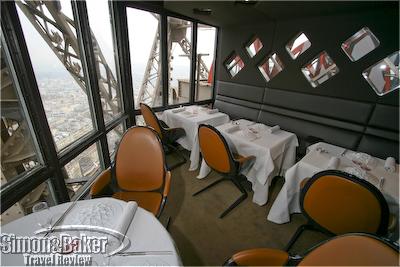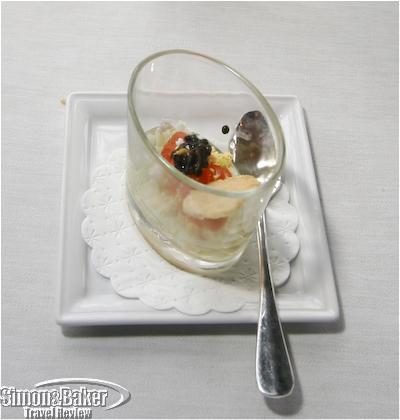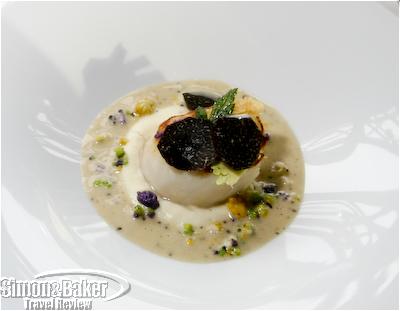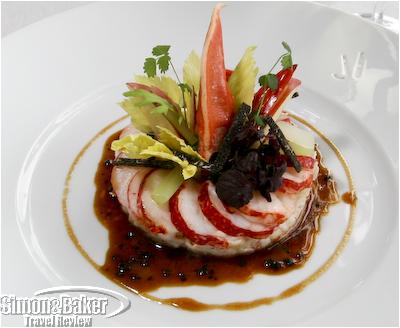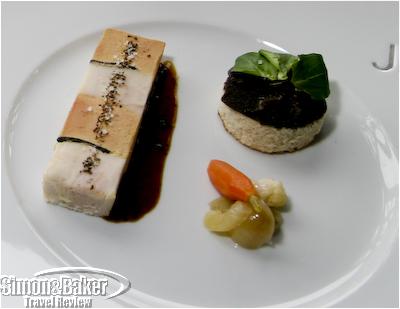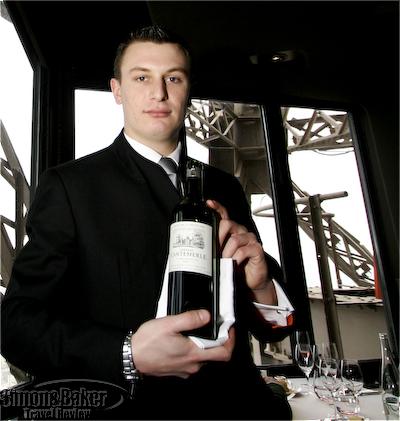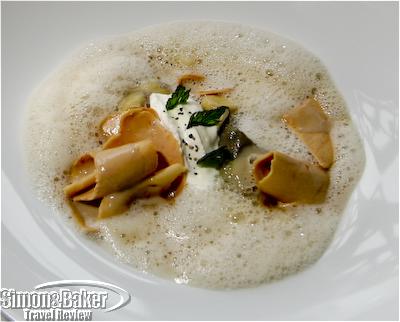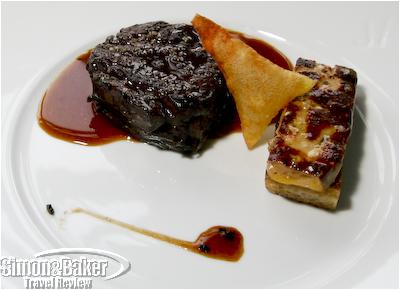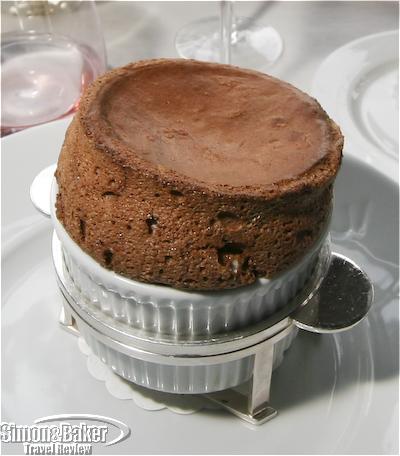
Our overall experience was worth repeating and recommending thanks to a combination of pleasant and efficient service, stylish and understated décor and an outstanding meal. In addition, our window side table afforded us a magnificent north facing view of the Seine and one of the city’s most exclusive neighborhoods. Even on a gray winter day the view was stunning.
Inside the venerable restaurant the setting was memorable. We noticed the distinctive Jules Verne dinnerware and Orfrevie de France silverware as well as countless details to remind us this was a special place, the gourmet restaurant at the Eiffel Tower. It was the kind of place we want to return to for special occasions like birthdays, holidays, and anniversaries.
Every table, save one, in our corner of the dining room was a couples table. At least one young man looked like he might be proposing that day, and at a nearby window side table we spotted an international rock star celebrating his wife’s birthday with a surprise gift brought by a waiter. They looked very happy.
This renewed French landmark restaurant has a new lease on life. We greatly enjoyed the world class contemporary French dining and romantic setting with an impressive view. We look forward to returning as soon as we can find a suitable excuse, I mean occasion, to celebrate.
Executive Chef Pascal Féraud was assisted by three sous chefs, Jemmy Brouet, Sébastien Péjus and Christophe Quentin.
Handicapped Access There was an elevator from the ground level entrance.
Location On the second level of the Eiffel Tower at the south Pillar, about 125 meters above ground.
Managed The French monument is operated and managed under a public service contract by Société d’Exploitation de la Tour Eiffel(SETE), a public-private partnership, in which the City of Paris has a 59.9 percent stake.
Opened-Renovated Although the Eiffel Tower opened to the public in 1889, Le Jules Verne as it exists today was only built in 1983. The latest reincarnation of the tower’s restaurant was completed December 2007.
Owned The building it is government owned.
Pastry Chef Christophe Devoille worked at La Côte Basque in New York. In 2004, he became pastry chef at Retaurant Alain Ducasse au Plaza Athenee. In 2006, he worked at Antoine Westermann’s Buerehiesel.
Restaurant Manager Frédéric Rouen was in charge of the dining room. Prior to his work at the Jules Verne, he worked at the Royal Club Evian, Connaught Hotel in London, with Joël Robuchon at Jamin and later with Alain Ducasse . Françis Coulon, who has been first maître d’hôtel at LeJulesVerne since 2001 assisted Rouen. Prior to his work at the Eiffel Tower, he worked at Le Clos Longchamp in Paris, L’Oasis in Mandelieu-la-Napoule, the Beau Rivage in Condrieu and the Gavroche in London.
Size The restaurant which is manned by 105 staff members including 47 in the kitchen can accommodate up to 120 guests. We estimated the size to be about 600 square meters.
Sommeliers Amar Chebrek and Roberto Amadei were in charge of the wines. Amadei worked Hilton in Rome, Savoy Palace in London, Tour d’Argent in Paris, first as commis de salle and then commis de sommellerie. In 2006, he joined the Four Seasons George V. Pierre-Jean Cosson selected wines for our meal.
Type Of Restaurant Contemporary French cuisine created “to reacquaint the French with the incomparable talent of their culinary heritage and extends an open invitation to visitors from around the world.”
Staff uniforms were by Lanvin 15 Faubourg. There were French porcelain J.L. Coquet plates, and plates, including the distinctive presentation plate, specially designed for Le Jules Verne by Pierre Tachon of Soins Graphiques. There were also rare items from the Orfèvrerie Béard in Montreux, silver-plated nickel-silver cutlery designed by the Orfèvrerie de France, and ebony carving knives crafted by the Coutellerie Chambriard in Thiers. There were also MD Crystal and carafes from the Vallerysthal glassworks in Lorraine.
Special Menus There was a three course Menu Dejeuner (Lunch Menu) available Monday to Friday for lunch for 85 euros (120 euros with wine pairing); and a six course Gourmet Tasting Menu for 200 euros.
The wine steward matched AOC (appellation d’origine controllée, French for controlled term of origin) wines by the glass with our meal as follows (in the order in which they were served): Condrieu 2007 Domaine Vallet, Haut Médoc 2004 Chateau Cantemerle, Muscat de Fiontignan 2005 Cuvée Belle Etoile Domaine Peyronnet and Maury 2007 “Vendage” Domaine Pouderoux.
To adjust to the space constraints of the Eiffel Tower kitchen, 70 square meters of additional kitchen space were set aside in a nearby building beneath the Champs de Mars,100 meters from the South Pillar where the restaurant is located. It was there that raw materials such as fish and vegetables were first processed before they being transported to the main kitchen of Le Jules Verne.
As we departed one of the staff members handed us a complimentary madeleine pastry to take home. For those wishing something more lasting there were souvenirs available for purchase among them the “Structure” presentation plate by Pierre Tachon we had seen at our table when we arrived, books by Alain Ducasse and numbered porcelain dolls created by Alber Elbaz for Lanvin.
Service Service was cordial and attentive.
Would You Dine Eat There Again-Recommend It? Yes
Contact Information
- Address:
- Tour Eiffel
- Avenue Gustave Eiffel
- 75007 Paris
- France
- Phone:
- +33 01 45 55 61 44
- Website:
